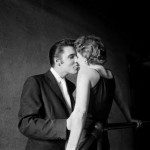‘Elvis at 21’ Photographer Alfred Wertheimer Dies at 84
By • November 6, 2014 0 1703

The photographer Alfred Wertheimer passed away on Oct. 19 in New York.
Elvis Presley lives on and on in the photographs of Wertheimer, who captured the budding king of rock and roll in 1956 with close to 3,000 images, taken over a period of a week in which he stayed in close proximity to Presley, traveling to New York, on the Steve Allen Show, on a train to Memphis, in Richmond for a concert, in hotels, at a diner, in the spotlight, and away from it, and finally at home, with his parents and friends.
Those pictures—before Elvis became irretrievably a legend—are as fresh as the other day. You can hear things in them, see the energy, and the charisma, and the response, and more than that they’re a kind of portrait of the life and times, his life and times, and for some of us who were unbelievably young then, our life and times.
The rest of the story is the music, which is permanent, for always and the rest of the days, never lost, always new.
John Lennon once famously said, “Before Elvis, there was nothing.”
Wertheimer, who was the son of German immigrants who escaped from Nazi Germany, was a free-lancer in 1956, struggling to get assignments, place photos, a 26-year-old not far removed from Elvis who was 21 then, fresh as a dangerous daisy. The thing was: Wertheimer was not exactly a rock-and-roll baby at the time. Asked to take on the assignment of shooting Elvis for more than a week, his first response was, “Who’s Elvis Presley?”
You can’t tell by the pictures, which he kept even after he moved on to other work over the years. One of them found its way onto the cover jacket of “Last Train to Memphis,” part one of the two-part definitive biography (Part two is “Careless Love”) by Peter Guralnick, who also wrote a biography about the troubled, bluesy balladeer of rock-pop Sam Cooke. That image—Elvis in an empty hall, hunched intently over a piano—was spotted by Chris Murray in 1995, who was intrigued. In the mid-90s, he found Wertheimer in New York, alive and well, putting together his Elvis collection. Govinda showed some of those images in a small, but compact, and evocative exhibition back then.
That first show evolved into another show at Govinda, and then an even bigger exhibition, co-sponsored by the Smithsonian Institution, which turned into a national tour. “Elvis at 21, New York to Memphis” had a lengthy stay at the National Portrait Gallery in 2010. It’s where we saw Wertheimer at the NPG, regaling visitors and critics with stories of shooting Elvis, a bearded man happy in his task of overseeing a party at Georgetown sculptor John Dreyfuss’s Halcyon House, watching as notables (Murray, House Speaker Nancy Pelosi and a host of others) danced away to rock-a-billy music.
Thousands saw the exhibition, with Wertheimer’s photographs enlarged into almost noise-and-atmosphere-filled examples of drama and action—in them, you can hear the trains, smell the diner food of the day’s special, hear the splash of water at a swimming pool, listen to the preternatural screaming of totally gone girls of the time, hear the whispering and murmuring, and the rustle of skirt against slacks that resulted in a now famous series of images, called “The Kiss.”
In his foreword to the book, Murray writes, “These photographs of Elvis Presley are without a doubt the most important and compelling images ever taken of the greatest rock-and-roll icon of all time. No other photographer has ever come closer to catching Elvis Presley’s magic than Alfred Wertheimer.”
In a tribute to Wertheimer on the Govinda web site, Murray describes the man as “thoughtful, truthful, imaginative, clever, supportive, tender, magnanimous, funny, talented and true friend.”
In the photographs of Elvis and his one-week milieu of traveling, you find the something—Elvis, to be sure, pouting, the great wavy mass of black hair, the intense look, even in repose, asleep, he’s a sight to see, the pelvis in action, mom and son, the mother and child revolution, reading an Archie comic book and a newspaper, the big, cocky smile, running in a field toward home in Memphis.
The pictures are so fresh, they seem not landlocked in 1956, but more like a vivid dream of your own life and memories.
The rest is music in our ears—“Love me tender, love me true,” “Jail House Rock” and “I wanna be your Teddy Bear,” jangled, back-of-a-truck stuff rock-and-roll forever true.
The image of him then, securely fixed into the forever, thanks to Alfred Wertheimer.
- Elvis at 21 “The Kiss” Courtesy of Govinda Gallery | Alfred Wertheimer



